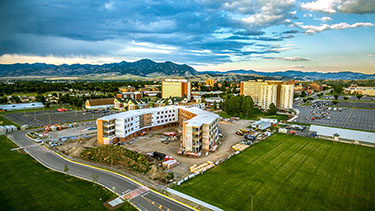|
Subscribe / Renew |
|
|
Contact Us |
|
| ► Subscribe to our Free Weekly Newsletter | |
| home | Welcome, sign in or click here to subscribe. | login |
Architecture & Engineering
| |
 |
October 29, 2015
Survey: NAC Architecture
Specialty: Education, healthcare, master planning, interior design, electrical engineering, graphics
Management: Dana Harbaugh, CEO
Founded: 1960
Offices: Seattle, Spokane and Los Angeles
2014 revenues: $26 million
Projected 2015 revenues: $30 million
Projects: Hazel Wolf K-8; Mount Si High School; Hamlin Robinson School; Bellevue College residence hall; Montana State University Yellowstone Hall
NAC Architecture has been growing fast and designing schools all over the Puget Sound region, as well as in Hawaii and Montana. Dana Harbaugh, the firm’s CEO, sat down with the DJC to talk about NAC’s growth and its outlook on Seattle.
Q: What are some trends in the industry?
A: Innovative design solutions that respond to and incorporate research in evidence-based design are more valued than ever by our clients. Clients want to know that their new buildings will help them and their patrons perform better in whatever service they provide.
Q: Which sectors have been the busiest for you?
A: Our healthcare practice was critical to our success in weathering the recession when community interest for investment in funding capital bond programs for education was low. Now that the economy has recovered, we are seeing an increase in our education projects that are publicly funded. Our healthcare market has remained strong over the past two or three years.
Q: How does Seattle compare to other markets you work in?
A: Of our three offices (Seattle, Los Angeles and Spokane), our Seattle office has seen the most significant growth in the past year. Since Jan. 1 of this year, the Seattle office has grown 43 percent and added 16 new people.
Q: Does environmental sustainability play a role in your firm?
A: Sustainable practices are integral to all our design solutions. LEED and WSSP (Washington Sustainable Schools Protocol) have become part of our expected design delivery process. We make a conscious effort to exceed predicted Energy Use Intensity (pEUI) on all our projects, cutting the predicted energy usage by as much as 50 percent or more over the average of similar project types on many of our projects. We also believe it’s important to display progressive sustainability practices in the building’s design, helping the building educate the public about how we can be better stewards of our environment.
Q: What do you see happening here over the next few years?
A: 2016 looks like it will be a robust year for our Seattle office. It will be interesting to see how long the current growth rate is sustainable.
Other Stories:
- Architects are the QB; meet the rest of the team
- Survey: Freiheit & Ho Architects
- Survey: Weber Thompson
- Survey: BCE Engineers
- Survey: ESM Consulting Engineers
- Survey: Davido Consulting Group
- Survey: Studio 19 Architects
- Installing an AV system? Try your IT network
- Dramatic tax change is good for in-state A&E firms
- A closer look at Seattle’s new NBA/NHL arena
- Seattle Pacific University retro-commissions 25 buildings
- What is Seattle's hot new neighborhood? LoSto
- A step-by-step guide to selecting a virtual design partner
- Group polishes guidelines for design-build projects
- Survey: Karen Kiest Landscape Architects



